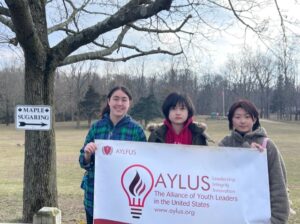Members of AYLUS Syosset attended a live presentation about the process of maple sugaring at Hoyt Farm Nature Preserve. Hoyt Farm is a nature preserve park that rescues various farm animals and gives presentations to the public about local wildlife and environmental awareness. Multiple speakers gave engaging talks about how maple syrup and maple sugar were and still are made. Three time periods were discussed: the 17th century involving the pre-contact Native Americans living on Long Island, the 18th century involving the first European settlers and modern day, involving the industries and technology that we’ve become familiar with. It was extremely fascinating to learn about how the process has changed and how maple syrup, especially maple trees, were used in the cultures and traditions of the people who relied on them. The Native Americans relied on maple trees and hand-made tools like the tomahawk to hack away at the wood in order to harvest the sap. Maple sap, as we’d been told, is made up of 97% water and only 3% sugar, so in order to obtain syrup and pure solidified maple sugar, the natives had to heat the sap for hundreds of hours. This discovery was vital during the long and harsh winters that often prevented tribes from having a sustainable source of food. During European colonization, the colonizers took from the ways of the natives and improved some of the steps and tools used. Though they were able to replace certain wooden tools and bowls with metal ones, they also had to wait arduous amounts of time to obtain syrup. Now, industries often use hydrometers and other high-tech machinery to efficiently produce syrup on a larger scale.
The speakers also gave real demonstrations on tapping trees. We watched Sheryl, one the presenters, tap a walnut tree and saw the natural sap dripping out.
Another aspect of maple sugaring that was discussed was the effects of climate change on the ability to obtain sap. There are a few main points that contribute to the decreased amount of sap retention in maple and walnut trees, some of the most important being the increase in severe weather patterns and global warming. Constantly changing weather patterns and warmer winters is not the ideal condition for trees to have a good sap supply and flow. Extremely cold nights and warmer days are needed to meet the ideal conditions. During the warmer seasons, the leaves photosynthesize and provide sugar for themselves and the tree. The leaves then fall when it becomes autumn and winter. The carbon dioxide trapped at the bottom of the tree pushes up the sap and allows it to produce a flow. However, the Hoyt Farm says that because of the lack of these conditions, their sap supply has been declining.
Lastly, members were able to taste the real maple syrup and sugar.
Alyssa Huang (2.5 h), Nichole Huang (2), Jessica Albrecht (2 h).





